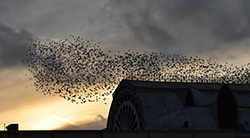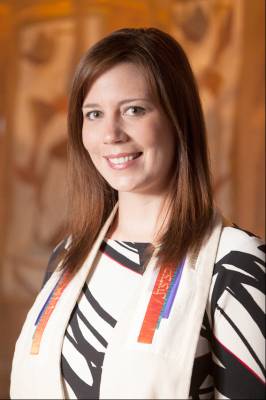 Think big. As a society, we value those who step beyond the status quo, who push us beyond what we think is possible. We think of them as heroic — because they possess a talent that we do not.
Think big. As a society, we value those who step beyond the status quo, who push us beyond what we think is possible. We think of them as heroic — because they possess a talent that we do not.
But what if thinking big were not a talent but a skill to be cultivated — something even God had to practice?
This week in Parashat Bo and last week in Parashat Va-eira, God goes through not one, not two, but ten plagues before finding that breakthrough — that thing that will both make Pharaoh free the Israelites and make the Israelites understand the importance of this event for generations.
Let’s put aside the ghastly nature of the plagues for a moment. Let’s release judgment about the fairness of Pharaoh’s hardened heart and the mass of Egyptian bystanders who suffered — because there’s something to be learned from God’s process through all of this.
First of all, God’s brainstorm must have been pretty spectacular. Blood, frogs, lice. You can almost picture God in front of a blank whiteboard telling the angels “there are no bad ideas.” With a whole array of options — some common, some magical — God picks one to start and goes with it.
But it becomes clear that with the first two attempts, God wasn’t thinking big enough. Pharaoh’s magicians replicated these early trials of blood and frogs with little difficulty. If the goal was to make Pharaoh cower into submission and inspire the Israelites indefinitely, God needed something bigger. With the plague of lice, there’s a small breakthrough. The Egyptian magicians cannot copy the action. By the time we hit boils, the Egyptian magicians not only cannot unlock the magic to replicate, but also, as the text tells us, suffer from the affliction themselves.
Unlike God freeing the Israelites, we certainly don’t want to culminate our work with the slaying of the firstborn of an entire people. But there is a lesson to be learned from the trial and error of the plagues that ultimately led to a breakthrough for God.
God offers an inspiring model for thinking big. It is not a moment of sheer genius. It is a consistent slog to the thing that will break through. With each attempt, there’s a sense of getting closer and closer to the big, breakthrough idea. God doesn’t get it right at the beginning of the process. But God doesn’t get discouraged from forging ahead either. Perhaps God foresaw Thomas Edison’s advice that ‘“Genius is 1% inspiration, 99% perspiration.”
When it comes to thinking big for ourselves, do we let ourselves try out impractical ideas that may not work? Do we create the space for imperfect attempts on our way to something extraordinary?
Design thinking is the latest trend to seep from Silicon Valley into mainstream culture and it posits that these “fast failures” aren’t incidental to breakthrough ideas — they’re essential. With each trial that you test out, you learn what works and what doesn’t, and then use that information to design the next prototype. You don’t spend months building up one idea only to learn that it’s not quite right. Failure of an idea in two days stings a lot less than failure after six months of pouring in sweat equity.
We have conditioned ourselves to believe that experimentation comes across as unfinished and unprofessional — as something that should be done behind-the-scenes and with limits. We get embarrassed by failure and want what we launch to be spectacular on the first try.
But when avoiding failure becomes our goal, we deprive ourselves of the very thing that we seek — a transformative breakthrough. If God had relied on a more traditional thinking that shied away from failure, we would never have been freed. We would have been lucky to have had a few people go out to the desert for three days of worship before returning back to bondage. We certainly wouldn’t have had endless generations share our defining moment as a people over an annual seder.
Big thinkers don’t happen upon world-changing ideas. They often painstakingly fail on their way there. So if genius isn’t an attribute but a process, imagine the untapped genius that lies in wait — in each and every one of us. The even better news is that in order to get there, all we have to do is to start failing our way to success.

When I look at the list of plagues, my first instinct is to cringe. What a terrible list of plagues that God sent and what a terrible ruler Pharaoh was to have allowed his people to suffer so. For me, it is almost impossible to put aside the discomfort I feel as I read about these plagues and imagine their impact. As our scholar asked above, so too do I wonder: Is there logic behind the increasing severity of the plagues? Surely God, as Creator of the entire universe, should have known that number 10 would be the exact amount of convincing a ruler would need to allow his slaves to go free. Indeed, why put everyone, Jews and Egyptians, Moses and Pharaoh, through the first nine at all?
With the nuance and complexity that accompanies this narrative, there are no shortage of explanations as to the purpose of these plagues. The biblical commentators Rashi (11th century, France) and Abravanel (16th century, Italy) both understand the plagues as educational in nature. They were meant to teach the Egyptians and the Israelites about God’s power and sovereignty, in direct opposition to Pharaoh’s claim on divinity. As God says in Exodus 7:5, “And the Egyptians shall know I am the Eternal.”
Another idea, suggested by the contemporary scholar Ziony Zevit,1 takes the theory one step further. In this line of thinking, each plague undoes some aspect of Creation as found in Genesis. Zevit explains that when Aaron refers to the bloodied waters of Egypt as a mikveh, “a gathering,” of the waters, we are meant to be immediately reminded of Genesis 1:10, when God splits the mikveh of waters on the third day from dry land. The fifth and sixth plagues, cattle disease and wild animals, took away all the animals. The seventh and eighth plagues, fiery hail and locusts, killed all of the plant life. The ninth plague recalls God’s ability to divide light from darkness: just as God separates darkness from light on the second day of Creation (Genesis 1:4), God sends darkness to all of the Egyptian households and light to only the homes of the Israelites (Exodus 10:23). The tenth and final plague, the death of the firstborn, takes back human life itself. In other words, the very thing that culminates God’s Creation is the same thing that culminates the height of destruction. “At the end of the narrative in Exodus,” Zevit remarks, “Israel looks back over the stilled water of the sea at a land with no people, no animals, and no vegetation, a land in which creation has been undone.”
With the increasing severity of the ten plagues, God is teaching the Egyptians, the Israelites, and us an important lesson. It is not just that God is the new and improved Sovereign. It is also that through an understanding of God’s power, we can see the inextricable link between nature and collective morality. As our planet and so many people all over the world suffer from the weight of our collective decisions as humankind to consume without regard to consequences, we are called in this parashah to reexamine our own relationship with God and our humble place in the cosmos, and to realign ourselves with goodness and life for the sake of all Creation.
1. As explored by Rabbi Shai Held in The Heart of Torah: Essays on the Weekly Torah Portion, Genesis and Exodus [Philadelphia: JPS, 2017]. p. 147-148
Bo, Exodus 10:1−13:16
The Torah: A Modern Commentary, pp. 448−471; Revised Edition, pp. 405–426
The Torah: A Women’s Commentary, pp. 355–378
Haftarah, Jeremiah 46:13−28
The Torah: A Modern Commentary, pp. 700−702; Revised Edition, pp. 427−429
Explore Jewish Life and Get Inspired
Subscribe for Emails


